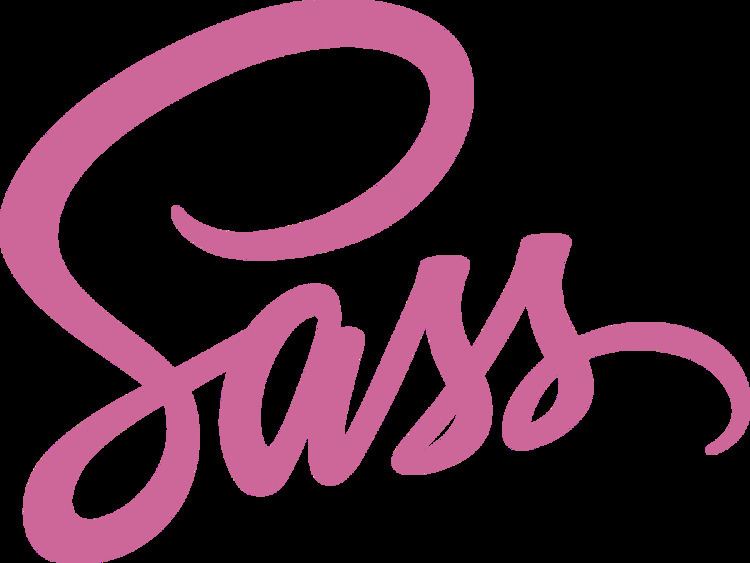Designed by Hampton Catlin Typing discipline dynamic | First appeared 2006 OS Cross-platform | |
 | ||
Developer Natalie Weizenbaum, Chris Eppstein Stable release 3.4.23 / December 19, 2016; 3 months ago (2016-12-19) | ||
Sass (syntactically awesome stylesheets) is a style sheet language initially designed by Hampton Catlin and developed by Natalie Weizenbaum. After its initial versions, Weizenbaum and Chris Eppstein continued to extend Sass with SassScript, a simple scripting language used in Sass files.
Contents
Sass is a scripting language that is interpreted into Cascading Style Sheets (CSS). SassScript is the scripting language itself. Sass consists of two syntaxes. The original syntax, called "the indented syntax", uses a syntax similar to Haml. It uses indentation to separate code blocks and newline characters to separate rules. The newer syntax, "SCSS", uses block formatting like that of CSS. It uses braces to denote code blocks and semicolons to separate lines within a block. The indented syntax and SCSS files are traditionally given the extensions .sass and .scss, respectively.
CSS3 consists of a series of selectors and pseudo-selectors that group rules that apply to them. Sass (in the larger context of both syntaxes) extends CSS by providing several mechanisms available in more traditional programming languages, particularly object-oriented languages, but that are not available to CSS3 itself. When SassScript is interpreted, it creates blocks of CSS rules for various selectors as defined by the Sass file. The Sass interpreter translates SassScript into CSS. Alternately, Sass can monitor the .sass or .scss file and translate it to an output .css file whenever the .sass or .scss file is saved. Sass is simply syntactic sugar for CSS.
The official implementation of Sass is open-source and coded in Ruby; however, other implementations exist, including PHP, and a high-performance implementation in C called libSass. There's also a Java implementation called JSass. Additionally, Vaadin has a Java implementation of Sass. The indented syntax is a metalanguage. SCSS is a nested metalanguage, as valid CSS is valid SCSS with the same semantics. Sass supports integration with the Firefox extension Firebug.
SassScript provides the following mechanisms: variables, nesting, mixins, and selector inheritance.
Variables
Sass allows variables to be defined. Variables begin with a dollar sign ($). Variable assignment is done with a colon (:).
SassScript supports four data types:
Variables can be arguments to or results from one of several available functions. During translation, the values of the variables are inserted into the output CSS document.
In SCSS style
Or SASS style
Would compile to:
Nesting
CSS does support logical nesting, but the code blocks themselves are not nested. Sass allows the nested code to be inserted within each other.
In SASS style
or SCSS style
Would compile to:
More complicated types of nesting including namespace nesting and parent references are discussed in the Sass documentation.
Or SASS style
Would compile to:
Loops
Sass allows for iterating over variables using @for, @each and @while, which can be used to apply different styles to elements with similar classes or ids.
The above example would compile to:
Arguments
Mixins also support arguments.
Would compile to:
In combination
Would compile to:
Selector inheritance
While CSS3 supports the Document Object Model (DOM) hierarchy, it does not allow selector inheritance. In Sass, inheritance is achieved by inserting a line inside of a code block that uses the @extend keyword and references another selector. The extended selector's attributes are applied to the calling selector.
Would compile to:
Sass supports multiple inheritance.
libSass
At the 2012 HTML5 Developer Conference, Hampton Catlin, the creator of Sass, announced version 1.0 of libSass, an open source C++ implementation of Sass developed by Catlin, Aaron Leung, and the engineering team at Moovweb. Current Sass maintainer, Chris Eppstein, has expressed intent to contribute as well.
According to Catlin, libSass can be "drop[ped] into anything and it will have Sass in it...You could drop it right into Firefox today and build Firefox and it will compile in there. We wrote our own parser from scratch to make sure that would be possible."
The design goals of libSass are:
